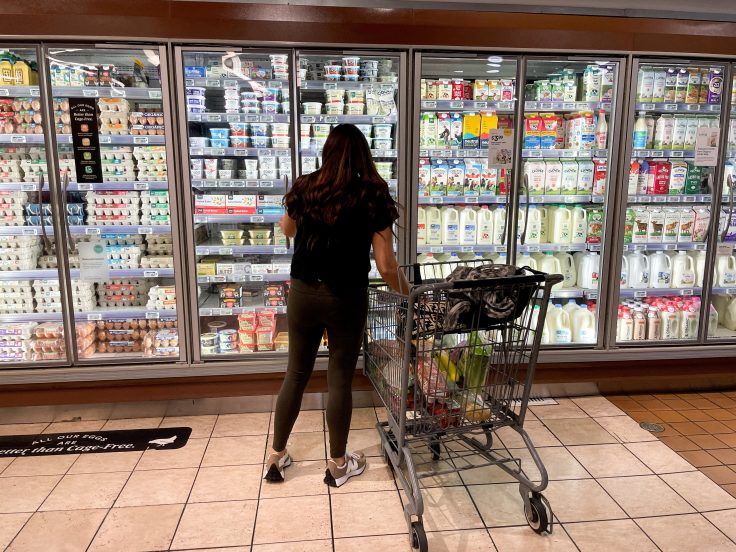WASHINGTON (Reuters)—U.S consumer prices rose less than expected in October, pushing the annual increase below 8% for the first time in eight months, the strongest signs yet that inflation was starting to subside, which would allow the Federal Reserve to dial back its hefty interest rate hikes.
The report from the Labor Department on Thursday also showed underlying consumer prices increasing moderately last month, sending the dollar tumbling against a basket of currencies and U.S. Treasury prices rallying in early trade. U.S. stocks opened sharply higher. The report followed on the heels of data last week showing some loosening in labor market conditions.
"Inflation is still too high, but there is evidence that the Fed has turned the corner in its fight and that the pace of future interest rate increases will begin to slow," said Christopher Rupkey, chief economist at FWDBONDS in New York.
"The market is on fire with the long-wished for inflation moderation finally starting to appear."
The consumer price index rose 0.4% last month after climbing by the same margin in September. Economists polled by Reuters had forecast the CPI would advance 0.6%. Soaring rents accounted for more than half of the increase in the CPI. Gasoline prices rebounded after three straight monthly decreases.
While food prices increased 0.6%, the pace was much slower relative to prior months. The price of food consumed at home rose 0.4%, the smallest gain since December 2021. There were increases in the prices of meats, poultry, fish, eggs, cereals and bakery products. But fruits and vegetables cost less.
In the 12 months through October, the CPI increased 7.7% after rising 8.2% on the same basis in September. It was the first time since February that the annual increase in the CPI was below 8%, and the smallest gain since January. The annual CPI peaked at 9.1% in June, which was the biggest advance since November 1981.
Annual inflation is slowing as last year's big increases drop out of the calculation.
The Fed last week delivered a fourth consecutive 75-basis-point interest rate hike and said its fight to lower inflation to the U.S. central bank's 2% target would require borrowing costs to rise further. It, however, signaled it may be nearing an inflection point in what has become the fastest rate hiking cycle since the 1980s.
Despite the rebound in gasoline, goods inflation is slowing as demand rotates back to labor-intensive services and fractured global supply chains recover.
Retailers are also sitting on excess merchandise, forcing them to offer discounts to clear shelves.
UNDERLYING INFLATION EASING
Excluding the volatile food and energy components, the CPI increased 0.3% last month after gaining 0.6% in September. The so-called core CPI is being driven by surging rents as soaring mortgage rates price out prospective buyers.
Owners' equivalent rent, a measure of the amount homeowners would pay to rent or would earn from renting their property, increased 0.6% after shooting up 0.8% in September.
There are, however, signs that rental inflation could soon moderate. The Zillow Observed Rent Index (ZORI), viewed by some economists as a good predictor of rental inflation, looks to have peaked in February on an annual basis. The divergence between the rent measures in the CPI, ZORI and other independent gauges is due to differences in rent growth for new tenants relative to the average increase for all tenants.
The CPI was also held back by decreases in the prices of used cars and trucks as well as apparel. Core goods prices fell 0.4% after being unchanged in September.
The core CPI increased 6.3% in the 12 months through October. The core CPI jumped 6.6% on a year-on-year basis in September.
The inflation boost from services is coming from wages amid tight labor market conditions. A second report from the Labor Department on Thursday showed the number of Americans filing new claims for unemployment benefits increased moderately last week.
Initial claims for state unemployment benefits rose 7,000 to a seasonally adjusted 225,000 for the week ended Nov. 5.
Economists had forecast 220,000 applications for the latest week. Though job growth is slowing, the labor market remains extremely tight. The government reported last week that nonfarm payrolls increased by 261,000 in October, the smallest gain since December 2020. Employment growth has averaged 407,000 per month this year compared with 562,000 in 2021.
The unemployment rate rose to 3.7% from 3.5% in September. Still, there were 1.9 job openings for every unemployed person at the end of September.
(Reporting by Lucia Mutikani; Editing by Paul Simao, Chizu Nomiyama and Andrea Ricci)
